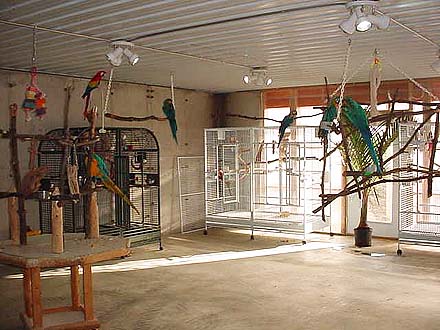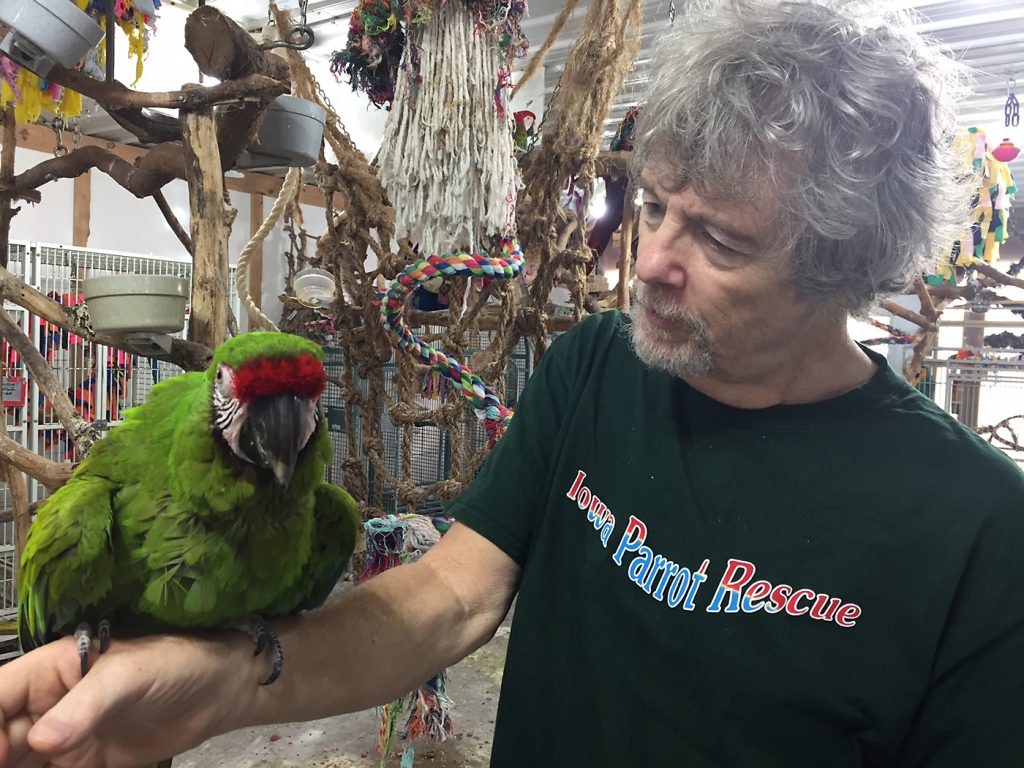
Mike Hutchison knows birds. “Birds have huge personalities. No other pet will sit on your shoulder and say ‘I love you’ and mean it,” he says. “No other pet can pet you.”
A bird can, according to Mike Hutchison, owner and operator of Iowa Parrot Rescue. Hutchison runs the bird sanctuary and adoption facility out of his family’s homestead in Letts, Iowa. They often take in abused and neglected birds. Other birds find their way to the parrot rescue when their owners are unable to keep them because of a health issue or a new baby in the family.
Ten years ago, Hutchison’s wife Abi received a canary as a Christmas gift. Soon an acquaintance asked if they would be willing to take in his bird. Mike started searching around on the Internet and found that people were always looking for homes for their birds.
And Iowa Parrot Rescue was born.
Birds as Pets
People often get birds not realizing how much time and attention they require. Birds need large cages, toys to entertain them, a diet of seeds, fresh fruits, and veggies, and frequent attention from the owners. As males reach sexual maturity, they often become aggressive and vocal, something many owners are unprepared to deal with.

“Most abuse [that we see] is neglect through ignorance,” Hutchison says. “[The owners] just don’t know what the bird needs.”
Other birds are impulse purchases. Since the 1990s there has been an increase in breeding and a decrease in importation, partially due to regulations like the Convention on International Trade of Wild Fauna and Flora that try to ensure animals are not harmed by international trade. Increased breeding resulted in lower prices, so people don’t always put as much thought into it, according to Hutchison.
The Rescues
At Iowa Parrot Rescue, some of the birds are permanent members of the sanctuary family, unsuitable for adoption for various reasons. Many have a difficult past, like Ziggy, an African Grey, who survived Hurricane Katrina. Others have health and aggression problems. Another bird, who came from a home with domestic violence, has an entire vocabulary of cries for help. Lacy and Leo, a pair of macaws that were left in their owner’s basement for 25 years, started plucking, a nervous habit of ripping out feathers that is caused by stress, malnutrition, or confinement.
Most birds, however, are available for adoption. The three-story house is home to the Hutchisons’ personal pets and some sanctuary birds that are not available for adoption, while a building on the property holds all the other birds currently in the their care. IPR generally has around 22 birds that range from the large and brilliantly colored macaws to smaller breeds like Indian Ringneck parakeets. Since its inception 10 years ago, the operation has dealt with more than 325 birds.
Because there is such a demand for the rescue and adoption facility, IPR has outgrown the Hutchisons’ house. Last summer, a new building was constructed just for the birds and they were all moved in by November 2008.
Devoted bird owners also frequently give their birds to Hutchison to place with another family or care for temporarily. Until the spring of 2008, Iowa Parrot Rescue was the only operation of its kind from Denver to Chicago. Now, thanks to a weekend workshop IPR hosted in May, there are a few more across the Midwest.
Last year, a woman paid him to fly to Fort Lauderdale, Florida, to get her bird after she was diagnosed with cancer. The woman said there were six bird rescues in her county alone but she didn’t like any of them. “It’s rewarding when a good owner feels comfortable giving their bird to you,” Hutchison says.
Though caring for 20 or more birds is a huge time commitment, Hutchison doesn’t mind. “The downsides are peripheral. So we don’t take vacations and there is some noise.”
However, IPR isn’t just for the birds. “We’re caring for birds but we’re also caring for people—those who can’t keep their birds and those who want [to adopt] birds. It’s a win-win-win situation.
“Some people have wanted their whole lives to have a certain type of bird,” he says. “There is an excitement being able to call that person and tell her to come over to pick her bird. A 40-year-old turns into a 5-year-old at Christmas.”
Walter Seaman, an associate math professor at the University of Iowa, has adopted two Blue Front Amazon parrots from IPR. After his Orange Wing Amazon passed away, he got the urge to get another bird. Seaman said he started looking at birds at places like Petland, but they were expensive and he felt guilty feeding the demand for baby parrots.
He began searching the Internet to see if there were older, previously owned birds available for adoption. He found Bogart, a male Blue Front Amazon, at Iowa Parrot Rescue and later adopted Jammers, also a Blue Front Amazon.
Bogart is aggressive and not a cuddly bird, while Jammers has some health issues, requiring special vitamins. But the two birds have bonded and preen each other.
In a video he shot of the pair, their personalities were evident. Jammers was singing in an operatic voice and dancing, while Bogart waved. Hutchison, too, is familiar with big bird personalities. Draco, a Blue and Gold Macaw, likes to play peekaboo by covering his eyes with his wing.
“They have brought fun and joy to the house,” Seaman says. “I’m happy I did it because so many need homes and we are giving them a good home.
Since the recession began, Iowa Parrot Rescue has tripled the number of birds it has taken in, while donations have dried up. If you would like to make a tax-deductible donation, email IAparrotrescue@aol.com or call 563-506-5479.
Mike Hutchison will give a presentation at the Quad City Parrot Society Fair, Milan Community Center, Sunday, September 20 2009.
